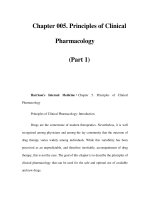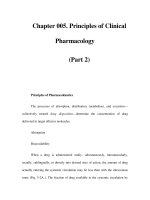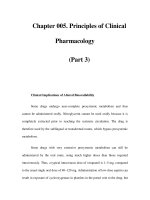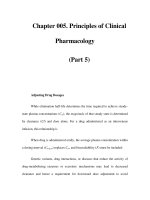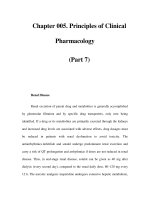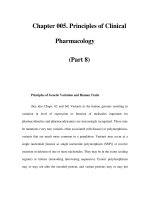Chapter 005. Principles of Clinical Pharmacology (Part 6) pdf
Bạn đang xem bản rút gọn của tài liệu. Xem và tải ngay bản đầy đủ của tài liệu tại đây (13.29 KB, 4 trang )
Chapter 005. Principles of Clinical
Pharmacology
(Part 6)
Principles of Dose Selection
The desired goal of therapy with any drug is to maximize the likelihood of
a beneficial effect while minimizing the risk of adverse effects. Previous
experience with the drug, in controlled clinical trials or in postmarketing use,
defines the relationships between dose (or plasma concentration) and these dual
effects and provides a starting point for initiation of drug therapy.
Figure 5-1 illustrates the relationships among dose, plasma concentrations,
efficacy, and adverse effects and carries with it several important implications:
1. The target drug effect should be defined when drug treatment is started.
With some drugs, the desired effect may be difficult to measure objectively, or the
onset of efficacy can be delayed for weeks or months; drugs used in the treatment
of cancer and psychiatric disease are examples. Sometimes a drug is used to treat a
symptom, such as pain or palpitations, and here it is the patient who will report
whether the selected dose is effective. In yet other settings, such as anticoagulation
or hypertension, the desired response is more readily measurable.
2. The nature of anticipated toxicity often dictates the starting dose. If side
effects are minor, it may be acceptable to start at a dose highly likely to achieve
efficacy and downtitrate if side effects occur. However, this approach is rarely if
ever justified if the anticipated toxicity is serious or life-threatening; in this
circumstance, it is more appropriate to initiate therapy with the lowest dose that
may produce a desired effect.
3. The above considerations do not apply if these relationships between
dose and effects cannot be defined. This is especially relevant to some adverse
drug effects (discussed in further detail below) whose development is not readily
related to drug dose.
4. If a drug dose does not achieve its desired effect, a dosage increase is
justified only if toxicity is absent and the likelihood of serious toxicity is small. For
example, a small percentage of patients with strong seizure foci require plasma
levels of phenytoin >20 g/mL to control seizures. Dosages to achieve this effect
may be appropriate, if tolerated. Conversely, clinical experience with flecainide
suggests that levels >1000 ng/mL, or dosages >400 mg/d, may be associated with
an increased risk of sudden death; thus dosage increases beyond these limits are
ordinarily not appropriate, even if the higher dosage appears tolerated.
Other mechanisms that can lead to failure of drug effect should also be
considered; drug interactions and noncompliance are common examples. This is
one situation in which measurement of plasma drug concentrations, if available,
can be especially useful. Noncompliance is an especially frequent problem in the
long-term treatment of diseases such as hypertension and epilepsy, occurring in
25% of patients in therapeutic environments in which no special effort is made to
involve patients in the responsibility for their own health. Multidrug regimens with
multiple doses per day are especially prone to noncompliance.
Monitoring response to therapy, by physiologic measures or by plasma
concentration measurements, requires an understanding of the relationships
between plasma concentration and anticipated effects. For example, measurement
of QT interval is used during treatment with sotalol or dofetilide to avoid marked
QT prolongation that can herald serious arrhythmias. In this setting, evaluating the
electrocardiogram at the time of anticipated peak plasma concentration and effect
(e.g., 1–2 h postdose at steady state) is most appropriate. Maintained high
aminoglycoside levels carry a risk of nephrotoxicity, so dosages should be
adjusted on the basis of plasma concentrations measured at trough (predose). On
the other hand, ensuring aminoglycoside efficacy is accomplished by adjusting
dosage so that peak drug concentrations are above a minimal antibacterial
concentration. For dose adjustment of other drugs (e.g., anticonvulsants),
concentration should be measured at its lowest during the dosing interval, just
prior to a dose at steady state (Fig. 5-4), to ensure a maintained therapeutic effect.
Concentration of Drugs in Plasma as a Guide to Therapy
Factors such as interactions with other drugs, disease-induced alterations in
elimination and distribution, and genetic variation in drug disposition combine to
yield a wide range of plasma levels in patients given the same dose. Hence, if a
predictable relationship can be established between plasma drug concentration and
beneficial or adverse drug effect, measurement of plasma levels can provide a
valuable tool to guide selection of an optimal dose. This is particularly true when
there is a narrow range between the plasma levels yielding therapeutic and adverse
effects, as with digoxin, theophylline, some antiarrhythmics, aminoglycosides,
cyclosporine, and anticonvulsants. On the other hand, if drug access to important
sites of action outside plasma is highly variable, monitoring plasma concentration
may not provide an accurate guide to therapy (Fig. 5-5A ).
Effects of Disease on Drug Concentration and Response


